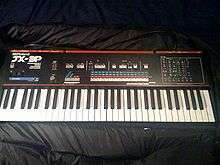Roland JX-3P
| Roland JX-3P | |
|---|---|
 Roland JX-3P | |
| Manufacturer | Roland |
| Dates | 1983-1985 |
| Price |
US $1395 UK £1075 |
| Technical specifications | |
| Polyphony | 6 voices |
| Timbrality | Monotimbral |
| Oscillator | 2 DCOs per voice |
| LFO | 1 sine/square/sh |
| Synthesis type | Analog Subtractive |
| Filter | 1 resonant lowpass, 1 highpass |
| Attenuator | 1 ADSR |
| Aftertouch expression | No |
| Velocity expression | No |
| Storage memory | 32 presets/32 user patches |
| Effects | chorus |
| Input/output | |
| Keyboard | 61 keys |
| External control | MIDI |
The Roland JX-3P is a synthesizer produced by Roland Corporation of Japan in 1983. The "3P" in its name refers to "Programmable Preset Polyphonic".[1] It is notable as one of the company's first products (along with the Jupiter-6) to incorporate a MIDI interface.
Features
The JX-3P is a six-note polyphonic, 61 key synthesizer with sawtooth, 50 and 10% pulse waveforms, and a noise generator. It has 32 factory programs in ROM, and user memory for 32 programs.
The JX-3P also features a built-in 128-step polyphonic sequencer that can be synchronized to external devices, such as drum machines, connected to its simple clock pulse input jack. MIDI clock synchronization is not supported.
As one of the earliest MIDI devices, the JX-3P's MIDI implementation is basic, supporting only note on/off, pitch bend, hold, modulation and program change messages. Neither "System Exclusive" nor "Continuous Controllers" (CC) are implemented, so external patch storage or real-time parameter updates are not possible through MIDI (except with third-party upgrades).
Juno-Series Lineage
The JX-3P's architecture is similar to the Juno series synths produced around the same time. Both machines employ the same interval-timer DCO technology, use the Roland IR3109 low-pass filter, a discrete VCA, and have an on-board stereo chorus effect. The JX-3P has a single ADSR envelope generator and a single modulation oscillator - both software-generated (while the Juno-6 and Juno-60 use analogue circuitry for the envelope generator, which achieves a more dynamic sound).
The Juno line had only a single DCO (with sub-oscillator) per voice, while the JX-3P had two distinct DCOs with detuning and several cross-modulation modes. Also unlike the Juno, the JX-3P allows the pitch of either oscillator to be controlled by its envelope generator. The Juno's features not included with the JX-3P were pulse width modulation, portamento and a second chorus mode.
MKS-30, PG-200
The JX-3P is fully programmable from its front panel. To do so, each synthesis parameter must be selected numerically, then its value can be adjusted with a single slider. For a more immediate programming experience, Roland offered the optional PG-200 "programmer", a simple control surface with dedicated switches and potentiometers for editing each of the JX-3P's parameters. It allows the user to edit patches with the conventional controls of an analog synthesizer. The PG-200 connects to the synthesizer through a proprietary interface. It is not possible to use the PG-200 and the MIDI interface at the same time, however.
A rackmount synthesizer similar to the JX-3P, the MKS-30 Planet-S, was also produced. Unlike the JX-3P, the MKS-30 would respond to velocity (dynamics) via MIDI, and can receive MIDI notes while simultaneously working with the PG-200 programmer.
The PG-200 programmer was also used with Roland's GR-700 Guitar Synthesizer.
There is an EPROM version available at Roland, which enables MIDI reception of note velocity.[2] There is an add-on kit available from Inque (see link below), which enables parallel usage of PG200 and MIDI and also introduces parameter control via MIDI controller data (and includes the functionality of the Roland EPROM update). The New Zealand based company Kiwitechnics offers an upgrade kit called "Kiwi-3P" which significantly enhances the functionality of the JX-3P.
References
- ↑ JX-3P Technical SpecificationsRoland U.S. Retrieved 3 April 2013.
- ↑ http://www.soundonsound.com/sos/1996_articles/feb96/rolandjx3p.html
External links
- JX-3P owner's manual
- MKS-30 owner's manual
- Florian Anwander's Page - Schematics, Modifications, Hidden Functions
- Vintage Synth Explorer's JX-3P entry
- Homepage of expansion kit from Inque
- Homepage of the upgrade kit from Kiwitechnics
- Info, manual & MP3 demo